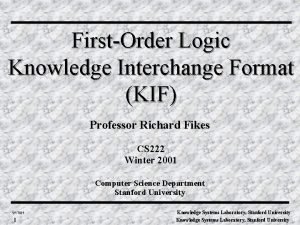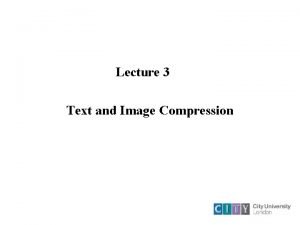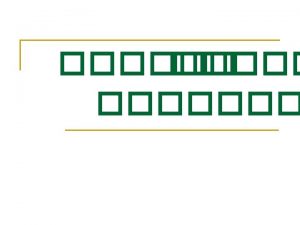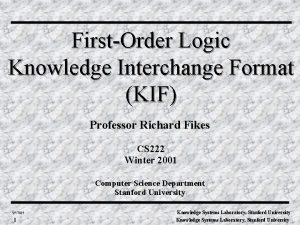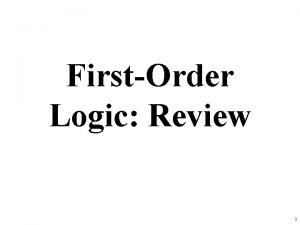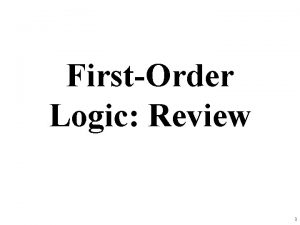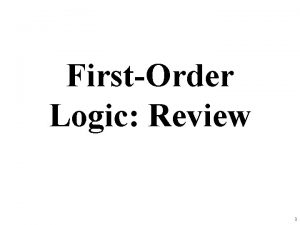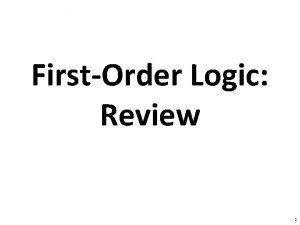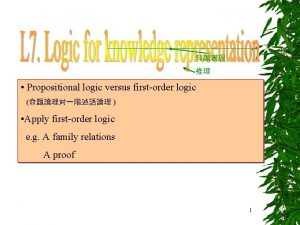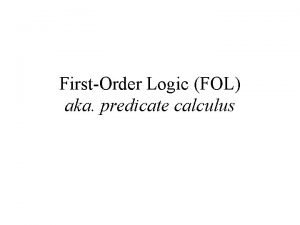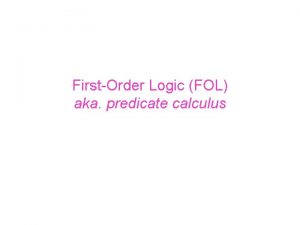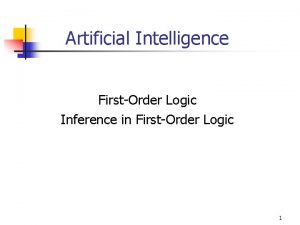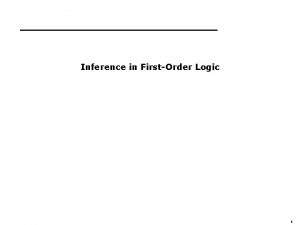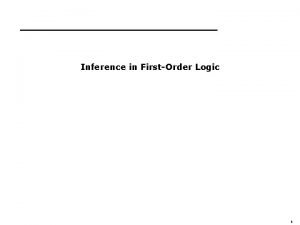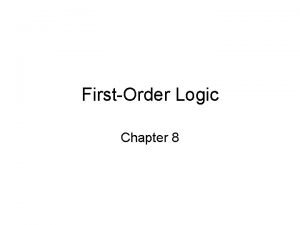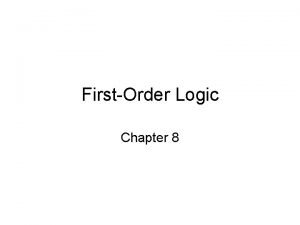FirstOrder Logic Knowledge Interchange Format KIF Professor Richard








![Function Terms and Relational Sentences u Function Term ä (<function constant> <term>* [<sequence variable>]) Function Terms and Relational Sentences u Function Term ä (<function constant> <term>* [<sequence variable>])](https://slidetodoc.com/presentation_image/42cd0eef3478980eb25ae958cc6932a4/image-9.jpg)






![Logical Terms u (if <sentence> <term> [<term>]) E. g, (if (Above A B) ä Logical Terms u (if <sentence> <term> [<term>]) E. g, (if (Above A B) ä](https://slidetodoc.com/presentation_image/42cd0eef3478980eb25ae958cc6932a4/image-16.jpg)









- Slides: 25

First-Order Logic Knowledge Interchange Format (KIF) Professor Richard Fikes CS 222 Winter 2001 Computer Science Department Stanford University 1/17/01 1 Knowledge Systems Laboratory, Stanford University

KR Language Components u A logical formalism ä Syntax for wffs ä Vocabulary of logical symbols (e. g. , AND, OR, NOT, =>, <=>) ä Interpretation semantics for the logical symbols E. g. , “(=> A B)” is true if and only if B is true or A is false. u An ontology ä Vocabulary of non-logical symbols > Relations, functions, constants ä Definitions of non-primitive symbols E. g. , (<=> (Bachelor ? x) (AND (Man ? x) (Unmarried ? x))) ä Axioms restricting the interpretations of primitive symbols E. g. , (=> (Person ? x) (Gender (Mother ? x) Female)) u A proof theory ä Specification of the reasoning steps that are logically sound E. g. , From “(=> S 1 S 2)” and “S 1”, conclude “S 2”. 2 Knowledge Systems Laboratory, Stanford University

Interlingua for Multi-Use Knowledge Language 1 . . . Language 2 Language n KIF KB Library u Knowledge Interchange Format (KIF) ä First order predicate logic ä Includes numbers, lists, and strings ä Linear ASCII syntax ä In the process of becoming an ANSI standard 3 Knowledge Systems Laboratory, Stanford University

Conceptualization u Set of objects about which knowledge is being expressed ä Universe of discourse ä Objects can be – > > > Concrete Abstract Primitive Composite Fictional Clyde, my car Justice, 2 Resister Electric circuit Sherlock Holmes ä Objects always in the conceptualization (i. e. , in the ontology) > > > u 4 Real and complex numbers All finite lists of objects Words ASCII characters Finite strings of ASCII characters ^ (bottom) Set of relations and functions on the objects Knowledge Systems Laboratory, Stanford University

Conceptualization u Set of objects about which knowledge is being expressed ä Universe of discourse u Set of relations and functions on the objects ä Relation > Set of finite lists of objects E. g. , Parent: {(Richard Earl) (Richard Polly) (Debbie Don) … } > Mapping: <list of objects> ® <truth value> ä Function > Relation that has a unique nth element for a given n-1 elements E. g, +: {(1 3 4) (17 23 40) (2 7 10 12 31) …} > Referred to as (arg 1, arg 2, … , argk, value) > Mapping: <list of objects> ® <object> 5 Knowledge Systems Laboratory, Stanford University

Blocks World a b d c e Objects - a, b, c, d, e, table 6 Knowledge Systems Laboratory, Stanford University

Blocks World a u Objects a, b, c, d, e, table u Relations b d c e ä Above: {(a b) (a c) (b c) (d e)} ä Clear: {(a) (d)} ä Table: {(c) (e)} u Functions ä On: {(a b) (b c) (d e)} 7 Knowledge Systems Laboratory, Stanford University

KBs, Sentences, Terms, Words u Knowledge Base – Collection of sentences u Sentence – Expression denoting a statement u Term – Expression denoting an object u Words ä Constant > Word not beginning with “? ” or “@” E. g. , Fred, Block-A, Justice ä Individual Variable > Word beginning with “? ” E. g, ? x, ? The-First-Murderer ä Sequence Variable > Word beginning with “@” E. g, @x, @The-Other-Murderers 8 Knowledge Systems Laboratory, Stanford University
![Function Terms and Relational Sentences u Function Term ä function constant term sequence variable Function Terms and Relational Sentences u Function Term ä (<function constant> <term>* [<sequence variable>])](https://slidetodoc.com/presentation_image/42cd0eef3478980eb25ae958cc6932a4/image-9.jpg)
Function Terms and Relational Sentences u Function Term ä (<function constant> <term>* [<sequence variable>]) E. g. , (plus 2 3) (Father-Of Richard) (plus 4 ? x @Other-Addends) u Relational Sentence ä (<relation constant> <term>* [<sequence variable>]) E. g, (Parent Richard Earl) (Clear A) (Set-Partition Set 1 @Sets) ä Equations – (= <term>) E. g, (= (Father Richard) Earl) (= A B) ä Inequalities – (/= <term>) E. g, (/= (Father Richard) (Father Bob)) (/= A B) 9 Knowledge Systems Laboratory, Stanford University

Declarative Semantics u Interpretation of a constant – ä ä u <object constant> Þ <object> <logical constant> Þ <truth value> <relation constant> Þ <relation> <function constant> Þ <function> Variable assignment – ä <individual variable> Þ <object> ä <sequence variable> Þ <finite sequence of objects> u Semantic value of a term – <term> Þ <object> ä Defined in terms of an interpretation and variable assignment u Truth value of a sentence – <sentence> Þ {true, false} ä Defined in terms of an interpretation and variable assignment u 10 Version of a variable assignment Knowledge Systems Laboratory, Stanford University

Semantic Value u Denote “semantic value” by “SIV” ä I is an interpretation ä V is a variable assignment u Semantic value of a constant ä SIV(<constant>) = I(<constant>) u Semantic value of a variable ä SIV(<variable>) = V(<variable>) u Semantic value of a function term ä SIV((fn term 1 … termn)) = The object O such that áSIV(term 1) … SIV (termn) Oñ is a member of set I(fn) ä SIV((fn term 1 … termn @var)) = The object O such that áSIV(term 1) … SIV(termn) | V(@var) Oñ is a member of set I(fn) 11 Knowledge Systems Laboratory, Stanford University

Truth Value u Denote “truth value” by “TIV” ä I is an interpretation ä V is a variable assignment u Logical constants ä Tiv(<constant>) = I(<constant>) ä Tiv(true) = true ä Tiv(false) = false u Truth value of a relational sentence ä TIV((rel term 1 … termn)) = > true when áSIV(term 1), … , SIV (termn)ñ is a member of set I(rel) > false otherwise ä TIV((rel term 1 … termn @var)) = > true when áSIV (term 1), … , SIV (termn) | SIV (@var)ñ is a member of set I(rel) > false otherwise 12 Knowledge Systems Laboratory, Stanford University

Equations and Inequalities u Equations ä TIV((= term 1 term 2)) = > true when SIV(term 1) and SIV(term 2) are the same object > false otherwise u Inequalities ä TIV((/= term 1 term 2)) = TIV((not (= term 1 term 2))) 13 Knowledge Systems Laboratory, Stanford University

Logical Sentences: not, and, or u Negation – (not <sentence>) E. g. , (not (On A D)) (not (On B B)) ä TIV((not sent)) = > true when TIV(sent) is false > false otherwise u Conjunction – (and <sentence>*) E. g. , (and (On A B) (On B C)) ä TIV((and sent 1 … sentn)) = > true when TIV(senti) is true for all I = 1, … , n > false otherwise u Disjunction – (or <sentence>*) E. g. , (or (On A D) (On A B)) ä TIV((or sent 1 … sentn)) = > true when TIV(senti) is true for some I = 1, … , n > false otherwise 14 Knowledge Systems Laboratory, Stanford University

Logical Sentences: => <= <=> u Implication – (=> <sentence>* <sentence>) E. g. , (=> (On A B) (On B C)) ä TIV((=> ante 1 … anten conse)) = > true when: – TIV(antei) is false for some I = 1, … , n; or – TIV (conse) is true > false otherwise E. g. , (=> (On A D) (On D D)) ä TIV((=> a 1 … an c)) = TIV ((or (not a 1) … (not an) c)) u Implication – (<= <sentence>*) u Logical equivalence – (<=> <sentence>) ä TIV ((sent 1 <=> sent 2)) = > true when TIV (sent 1) = TIV (sent 2) > false otherwise ä TIV((<=> s 1 s 2)) = TIV((and (=> s 1 s 2) (=> s 2 s 1))) 15 Knowledge Systems Laboratory, Stanford University
![Logical Terms u if sentence term term E g if Above A B ä Logical Terms u (if <sentence> <term> [<term>]) E. g, (if (Above A B) ä](https://slidetodoc.com/presentation_image/42cd0eef3478980eb25ae958cc6932a4/image-16.jpg)
Logical Terms u (if <sentence> <term> [<term>]) E. g, (if (Above A B) ä SIV((if sent term)) = > SIV(term) when TIV(sent) = true > ^ otherwise ä SIV((if sent term 1 term 2)) = > SIV(term 1) when TIV(sent) = true > SIV(term 2) otherwise u (cond (<sentence> <term>) … (<sentence> <term>)) E. g. , (cond ((Above A B) A) ((Above B A) B)) ä SIV((cond (sent 1 term 1) … (sentn termn))) = > SIV(term 1) when TIV(sent 1) = true. . . > SIV(termn) when TIV(sentn) = true > ^ otherwise 16 Knowledge Systems Laboratory, Stanford University

Declarative Semantics u Interpretation of a constant – ä ä u <object constant> Þ <object> <logical constant> Þ <truth value> <relation constant> Þ <relation> <function constant> Þ <function> Variable assignment – ä <individual variable> Þ <object> ä <sequence variable> Þ <finite sequence of objects> u Semantic value of a term – <term> Þ <object> ä Defined in terms of an interpretation and variable assignment u Truth value of a sentence – <sentence> Þ {true, false} ä Defined in terms of an interpretation and variable assignment u Version of a variable assignment V’ is a version of a variable assignment V with respect to variables v 1, …, vn if and only if V’ agrees with V on all variables except v 1, …, vn. 17 Knowledge Systems Laboratory, Stanford University

Universally Quantified Sentences u (forall <individual variable> <sentence>) E. g, (forall ? b (not (On ? b))) ä TIV((forall ? var sent)) = > true when TIV’(sent) = true for all versions V’ of V with respect to variable ? var > false otherwise u (forall (<individual variable>*) <sentence>) E. g. , (forall (? b 1 ? b 2) (=> (On ? b 1 ? b 2) (Above ? b 1 ? b 2))) ä TIV ((forall (? var 1 … ? varn) sent)) = > true when TIV’(sent) = true for all versions V’ of V with respect to ? var 1 … ? varn > false otherwise 18 Knowledge Systems Laboratory, Stanford University

Existentially Quantified Sentences u (exists <individual variable> <sentence>) E. g, (forall ? b 1 (or (on ? b 1 table) (exists ? b 2 (On ? b 1 ? b 2)))) ä TIV((exists ? var sent)) = > true when TIV’(sent) = true for some version V’ of V with respect to variable ? var > false otherwise u (exists (<individual variable>*) <sentence>) E. g. , (exists (? b 1 ? b 2) (and (On ? b 1 ? A) (Above ? A ? b 2))) ä TIV ((exists (? var 1 … ? varn) sent)) = > true when TIV’(sent) = true for some version V’ of V with respect to ? var 1 … ? varn > false otherwise u forall not in the scope of an exists may be omitted E. g, (or (on ? b 1 table) (exists ? b 2 (On ? b 1 ? b 2))) 19 Knowledge Systems Laboratory, Stanford University

Digital Circuit C 1 Addends In Sum Out Carry In Carry Out Russell and Norvig, Figure 8. 1 20 Knowledge Systems Laboratory, Stanford University

Domain Conceptualization u Objects ä ä ä u Circuits Terminals Signals Gate types Signal values Relations ä Connected: (<terminal>) u Functions ä ä 21 Type: <gate> ® <gate type> In: (<index> <gate>) ® <input terminal> Out: (<index> <gate>) ® <output terminal> Signal: <terminal> ® <signal value> Knowledge Systems Laboratory, Stanford University

Electronic Circuit Domain Theory u Connected terminals have the same signal (=> (Connected ? t 1 ? t 2) (Signal ? t 1 (Signal ? t 2))) (=> (Connected ? t 1 ? t 2) (= (Signal ? t 1) (Signal ? t 2))) u Signal at terminal is either on or off (or (Signal ? t On) (Signal ? t Off)) (not (= On Off)) u Connected is commutative (<=> (Connected ? t 1 ? t 2) (Connected ? t 2 ? t 1)) 22 Knowledge Systems Laboratory, Stanford University

OR and AND Gates u OR gate’s output is on when any of its inputs are on (=> (Type ? g OR) (<=> (Signal (Out 1 ? g) On) (exists ? i (Signal (In ? i ? g) On)))) u AND gate’s output is off when any of its inputs are off (=> (Type ? g AND) (<=> (Signal (Out 1 ? g) Off) (exists ? i (Signal (In ? i ? g) Off)))) 23 Knowledge Systems Laboratory, Stanford University

XOR and NOT Gates u XOR gate’s output is on when its inputs are different (=> (Type ? g XOR) (<=> (Signal (Out 1 ? g) On) (not (Signal (In 1 ? g) (Signal (In 2 ? g)))))) u NOT gate’s output is different from its inputs (=> (Type ? g NOT) (not (Signal (Out 1 ? g) (Signal (In 1 ? g))))) 24 Knowledge Systems Laboratory, Stanford University

Circuit C 1 Representation u Gates (Type X 1 XOR) (Type A 1 AND) (Type O 1 OR) u (Type X 2 XOR) (Type A 2 AND) Connections (Connected (Out 1 X 1) (In 1 X 2)) (Connected (Out 1 X 1) (In 2 A 2)) (Connected (Out 1 A 2) (In 1 O 1)) (Connected (Out 1 A 1) (In 2 O 1)) (Connected (Out 1 X 2) (Out 1 C 1)) (Connected (Out 1 O 1) (Out 2 C 1)) 25 (Connected (In 1 C 1) (In 1 X 1)) (Connected (In 1 C 1) (In 1 A 1)) (Connected (In 2 C 1) (In 2 X 1)) (Connected (In 2 C 1) (In 2 A 1)) (Connected (In 3 C 1) (In 2 X 2)) (Connected (In 3 C 1) (In 1 A 2)) Knowledge Systems Laboratory, Stanford University
 Kif richard
Kif richard Rule interchange format
Rule interchange format Graphic interchange format
Graphic interchange format Direct sound create8 failed
Direct sound create8 failed Graphics interchange format definition
Graphics interchange format definition Cancelar
Cancelar Graphic interchange
Graphic interchange Ittra informali
Ittra informali Kif f08
Kif f08 Kif
Kif Ittra informali
Ittra informali Ittra elettronika formali
Ittra elettronika formali Promotion from associate professor to professor
Promotion from associate professor to professor Ucf richard quinn
Ucf richard quinn Mitral facies
Mitral facies Richard iii and looking for richard
Richard iii and looking for richard First order logic vs propositional logic
First order logic vs propositional logic First order logic vs propositional logic
First order logic vs propositional logic First order logic vs propositional logic
First order logic vs propositional logic Combinational vs sequential logic
Combinational vs sequential logic Cryptarithmetic problem logic+logic=prolog
Cryptarithmetic problem logic+logic=prolog Software development plan
Software development plan Is it x y or y x
Is it x y or y x Combinational logic sequential logic 차이
Combinational logic sequential logic 차이 Logic chapter 3
Logic chapter 3 The email
The email
